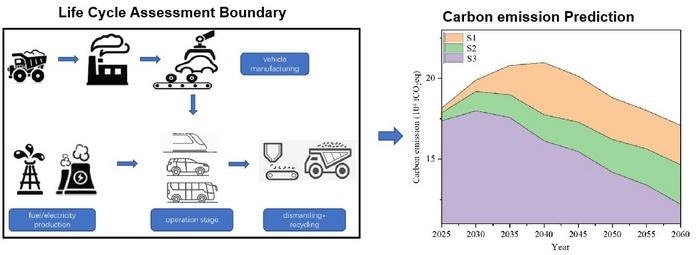The third-largest contribution to carbon emissions worldwide is transportation. Nations everywhere must take immediate action to address this situation.
 How Much Carbon Emissions Are Reduced by High-Speed Rail Travel. Image Credit: Yintao Lu, et al
How Much Carbon Emissions Are Reduced by High-Speed Rail Travel. Image Credit: Yintao Lu, et al
Due to their high level of electrification, high-speed rails (HSR) are seen as the primary route for intercity transit in the future. Nevertheless, there is a dearth of pertinent evidence to support the amount of carbon reduction that high-speed rail travel may achieve, as well as the best ways to regulate different modes of transportation.
Researchers at Beijing Jiaotong University conducted a recent study published in the journal High-Speed Railway, delving into the comprehensive assessment of vehicle life cycle carbon emissions.
The entire life cycle reflects the complete process of a product or tool, from natural resources use to its eventual return to nature. This mirrors the entire life process of human beings. Assessing carbon emissions throughout the entire life cycle provides a more accurate gauge of a product's environmental friendliness.
Lu Yintao, Associate Professor and Study Lead Author, School of Environment, Beijing Jiaotong University
Road transportation has historically been the primary means of passenger transportation. This includes automobiles, buses, and trains, all of which require using several energy sources, including electricity and gasoline. To determine which combinations of modes of transportation are most successful in lowering carbon emissions during travel, this study takes these aspects into account. It uses an evaluation unit based on the number of people per km.
The complete lifecycle carbon emission accounting of infrastructure is currently the focus of many studies on carbon reduction in vehicles. On the other hand, the perspective of the entire life cycle of cars and fuels was used to conduct this study.
Notably, when compared to infrastructure, vehicles are more consumable, whereas HSR demonstrates significant carbon emission reduction, with an intensity of only 24%-32% compared to private vehicles and 47%-89% compared to buses.
Lu Yintao, Associate Professor and Study Lead Author, School of Environment, Beijing Jiaotong University
The financing for this study not only helps reduce transportation-related carbon emissions but also gives vehicle manufacturers information about which materials to prioritize when producing new models because these materials have a big impact on reducing transportation-related carbon emissions.
Yao Hong, the study’s Principal Author, thinks that transportation-related carbon emissions are a continuous process significant to the overall life cycle of carbon emissions. She believes that this study will be able to theoretically back China’s efforts to reduce its carbon footprint in the transportation industry.
Journal Reference:
Lu, Y., et al. (2023). Carbon emissions reduction potentiality for railroad transportation based on life cycle assessment. Science Direct. /doi.org/10.1016/j.hspr.2023.08.004